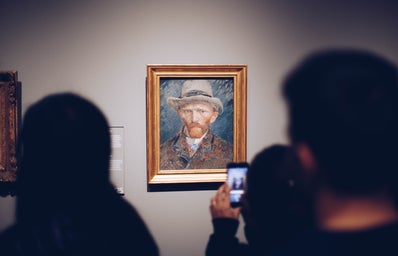Whether or not you’re majoring in art history — or already got your degree in art history — or working to get your BFA, you’re allowed to love art. I certainly do. And this is not to say that even as a self-proclaimed art-lover, one must be obsessed with all things art and be knowledgeable and all that. Below, I have included a compilation of my favorite art pieces I’ve seen from around the world, but I couldn’t tell you what the difference is between Michelangelo’s sculpting style and Vincenzo Pacetti’s (and if you don’t know who Vincenzo Pacetti is, neither did I — until I made this list because one of his pieces is included). That doesn’t mean, though, that I can’t enjoy art. In any field, people can fall into the discouraging trap of believing, “I must know everything or I’m not allowed to know anything.” Much the same way that, when young girls declare they, too, are fans of sports teams, they are immediately demanded by their male counterparts to recite the blood types of each player on every roster ever.
As a self-proclaimed-art-lover, I refuse to see this happen within my community.
For that reason, then, let me introduce you to some of the best pieces I’ve ever seen. You will find none of the “classics” on my list, which is why I find it to be even more valuable to the beginner self-proclaimed-art-lover. On my list, there is no Mona Lisa or Starry Night. Nor is there solely one style of art; instead, there is a mix of mediums and styles.
To begin, we have Athena of Velletri which is a ten-foot-tall sculpture by Vincenzo Pacetti, (I told you he would make an appearance) standing tall in Le Louvre in Paris, France. Frankly, the photos of Athena of Velletri don’t do her justice — this is a work of art that simply must be viewed in person; it is only here that one can be properly struck by her presence, left gaping in awe. This is what happened to me when I saw her this past summer. I was so mesmerized, in fact, that I proceeded to sit at the bench beside her and journal for an hour about how starstruck I was. As a likely minor in Ancient Greek studies, perhaps my bias runs high. But, Athena of Velletri is in the Louvre, after all.
Following, we have the Baroque oil-on-canvas Neptune and Amphitrite by Italian painter Sebastiano Ricci and featured in the Thyssen-Bornemisza Museo Nacional in Madrid, Spain. While Ricci’s painting is composed “with lively coloring and a striking range of chromatic nuances,” I was first drawn to it simply because sitting at the center is a woman. And not only that, but Amphitrite is clearly in a position of power. In Ricci’s oil painting, she sits in front of and slightly above Neptune who is the Roman god of the sea (more commonly known as Poseidon, in Greek mythology), AKA, one of the most powerful gods! Yet it is Amphitrite, a simple nereid — or sea nymph — who sits in a position more powerful than even him! Not only that, but her posture and her expression exude confidence and authority while Neptune beside her is looking up in what could be awe or fear. Absolutely brilliant, is what it is. So brilliant, in fact, that for a good while Neptune and Amphitrite were featured as my desktop background. After a few moments of looking at the painting, you’ll understand why.
Moving away from paintings and back to sculptures (and Paris), another splendid piece of art is The Caryatids, sculpted by Jean Goujon in 1550. Currently, The Caryatids stand at over 10-feet tall in the Salle des Caryatids in the Louvre. Like my experience with Athena of Velletri, Goujon’s caryatids are remarkable in their presence. While Neptune and Amphitrite was once featured as the background of my desktop, The Caryatids are currently featured on it. Their feminine presence radiates power and divinity; each time I open my computer, I look at them and remember standing before them in Paris. And then I channel that energy and take it with me to class.
Yes, clearly, I have a fascination with Greek mythology, and we are going to continue with that theme as I now introduce Jim Tierney’s The Rape of Persephone. As promised, though, the medium and style (and era!) have changed. The title of this work is a shame because that’s not really what is depicted in his print. The rape of Persephone is how the abduction of Persephone by Hades is referred to; in certain visual art pieces, the depictions are much more literal and violent. In Tierney’s interpretation, however, it is clearly a kidnapping and nothing more (at least in this one scene). Tierney’s print is not located in any museum (to my knowledge), but rather in a special edition of Edith Hamilton’s Mythology which I stumbled upon in Barnes & Noble this past year when it at last reopened after months of COVID. To be frank, the reason why I believe I was so struck by this piece is because of the fantastical, enemies-to-lovers passion it exudes. The male and female roles are traditional; Persephone is sweet and feminine with a look of longing on her face as Hades, with his enormous figure and menacing war dress, grasps her in his muscled arm while charging forward, driving his chariot. The story of Persephone and Hades is controversial, as one interpretation could be that he “stole” and raped her while another could be that they were lovers destined from the start to be together. As I am a passionate reader of the enemies-to-lovers fantasy genre, I like to believe the latter. Regardless, Jim Tierney’s work is exceptional. The colors are vibrant, and the emotion on both Hades’ and Persephone’s faces is striking enough to elicit emotion from the onlooker.
At last, moving away from Greek mythology, we have Looking Back, a photograph taken of jockey Ron Turcotte during the 1973 Belmont Stakes as he rode Secretariat into his Triple-Crown victory, setting a record that has yet to be broken. The first time I saw this “photo” was actually when I watched the 2010 movie Secretariat in theatres with my mother. To this day, it remains one of my favorite films; I watch it at least once a year and cry afterward every time. I grew up a horse-girl, and my mom and sister are still horse-girls, but that’s an article for another time. The point is that the scene in which the movie nods at Looking Back struck me even without having known that it was a famous shot. I later learned — my mother explained it to me — that the shot became so well-known because the number-one thing a jockey does not do is look back. It has the potential to set the horse off course or slow you down. But because Secretariat was thirty-one lengths ahead of the other horses — for reference, the winner of the 2021 Belmont Stakes won by only 1.25 lengths — Turcotte knew they had already won. In this case, the art itself strikes me less than the story depicted by it does. But, while I know nothing about photography, I imagine this is the goal of most photographers when displaying their shots.
Sticking with the horse theme and moving back into Greek mythology, I introduce you to Automedon with the Horses of Achilles by Henri Regnault which is a French Orientalist piece displayed in the Museum of Fine Arts in my hometown, Boston! This oil-on-canvas is, for lack of a better word, ginormous. The dimensions are 124 by 129.5 inches, which has it taking up nearly an entire wall. While Automedon is the central character in the piece, the size and wildness of the horses he holds is what had my eyes glued to the painting. As majestic as one could imagine a horse to look, these ones are even more so. Their coats are shining, their eyes are wild, their manes are thick and flowing; yet we are reminded by the frothing at their mouths and the way Automedon struggles to maintain his grip on their reins that they are still animals. It is utter perfection.
Our introduction to the best art pieces ends in Edinburgh, Scotland, in the National Galleries. The Monarch of the Glen by Sir Edwin Landseer is “one of the most famous British pictures of the nineteenth century.” Created in the Romantic era, the oil painting certainly romanticizes Scotland, “encapsulat[ing] the grandeur and majesty of Scotland’s highlands and wildlife.” The Monarch of the Glen is a painting of a stag from an angle slightly below so that his head is clearly held high, not one bit of his antlers hiding. The mountainous background is also an obviously intentional choice by Landseer, highlighting the “majesty” of Scotland’s land and nature in addition to its persona as embodied by the stag.
If these pieces spoke to you or didn’t — although I find it hard to believe not even one of them tickled your fancy — I hope you at least know that, now, you can enjoy art without knowing much about it. I mean, at the end of the day, you don’t have to justify why you love a piece of art. If it speaks to you, it speaks to you.


